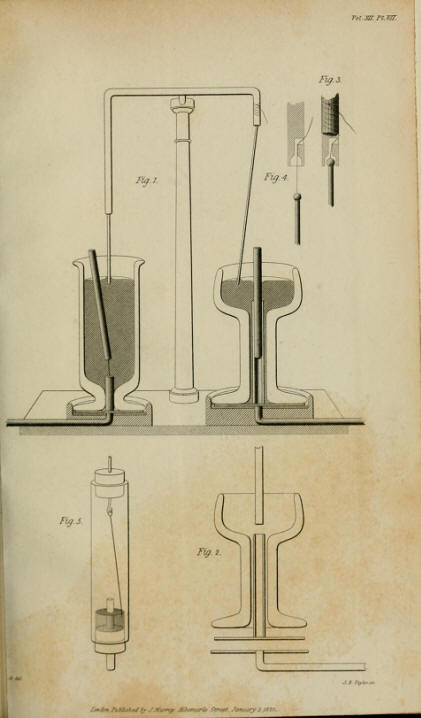|

Original plate illustrating Michael
Faraday's electric motor.
Credit:
Quarterly Journal of Science, Literature and the
Arts, 1821, volume XII
The Faraday Motor
May
10, 2011
Galaxies have been likened to
"homopolar motors" invented by
Michael Faraday. What are they and
how do they work?
It has been argued that galaxies
might behave like a device invented
by Michael Faraday, the homopolar
motor. A homopolar motor is driven
by magnetic fields induced in a
circular, rigid conductive metal
plate. The metal plate is placed
between the poles of an
electromagnet, causing it to spin at
a steady rate proportional to the
input current. The meter attached to
the wall in most backyards that
determines monthly electric bills is
a homopolar motor.
The homopolar motor owes its
existence to the discovery of
electromagnetism in 1820 by
Hans Christian Ørsted,
although that line extends much
farther back in time. It was a
so-called "voltaic pile," one of the
earliest batteries, that opened
Ørsted's eyes to the relationship
between electricity and magnetism.
In 1800,
Alessandro Giuseppe Antonio
Anastasio Volta invented an
apparatus made up of discs that
included copper, zinc, and cardboard
that was impregnated with a salt
solution. He alternately stacked the
discs and attached conductive wires
to the top and bottom of the stack.
When the two wires were connected in
a circuit, an electric current
flowed through the voltaic pile.
Ørsted noticed that a magnetized
compass needle was deflected from
its north-south orientation whenever
the compass came close to the
current flow. It was his observation
that electric current and magnetism
were related, coupled with
André-Marie Ampère's
mathematical analysis of said
"electromagnetic" effect, that
ultimately led to Faraday's
experiment.
Faraday built a device out of a
wire, a battery, and a mercury bath.
The wire hung down loosely from a
hook so that it made contact with
the mercury. A permanent bar magnet
stood upright in the mercury pool,
which was connected to the negative
battery terminal. The positive
battery terminal was connected to
the hook holding the wire. When
current ran through the circuit
going from positive to negative, the
wire's magnetic field interacted
with the bar magnet, causing a
circular magnetic field
around the wire, which began to spin
around the bar magnet.
A force that is at right angles
to both the direction in which a
charged particle is moving and the
direction of the applied field is
called the "Lorentz
force," and is an integral
component to the operation of a
homopolar motor.
The Dutch physicist Hendrik
Lorentz found that the velocity and
charge of a particle, as well as the
strength of a magnetic field,
influences the particle's direction
of travel. When current flows
through the homopolar motor's
conductive disc in a magnetic field,
a force acts on the charges in the
conductor, producing
torque that causes the
disc to spin around its pivot point.
As retired Professor of
Electrical Engineering
Don Scott wrote:
"In 1986, Nobel laureate Hannes
Alfven postulated both an electrical
galactic model and an electric solar
model. Recently physicist Wal
Thornhill has pointed out that
Alfven's circuits are really scaled
up versions of the familiar
homopolar motor that serves as the
watt-hour meter on each of our
homes. The simple application of the
Lorentz force equation ('crossing'
the direction, v, of the current
into the direction, B, of the
magnetic field) yields a rotational
force. Not only does this effect
explain the mysterious tangential
velocities of the outer stars in
galaxies, but also (in scaled down
version) the observed fact that our
Sun rotates faster at its equator
than at higher (solar) latitudes."
Stephen Smith
 New
DVD New
DVD
The Lightning-Scarred
Planet Mars
A video documentary that could
change everything you thought you
knew about ancient times and
symbols. In this second episode of
Symbols of an Alien Sky, David
Talbott takes the viewer on an
odyssey across the surface of Mars.
Exploring feature after feature of
the planet, he finds that only
electric arcs could produce the
observed patterns. The high
resolution images reveal massive
channels and gouges, great mounds,
and crater chains, none finding an
explanation in traditional geology,
but all matching the scars from
electric discharge experiments in
the laboratory. (Approximately 85
minutes)
Video Selections
Order Link
|





 New
DVD
New
DVD

